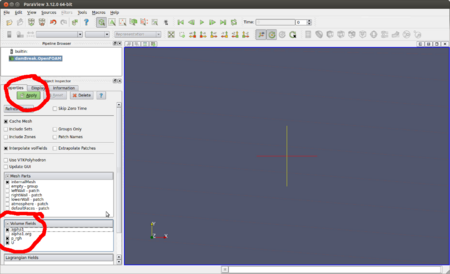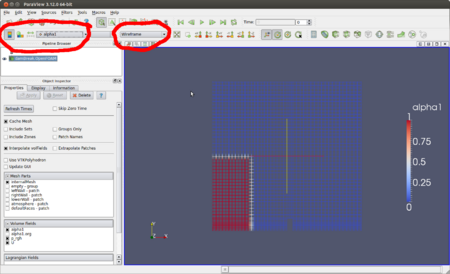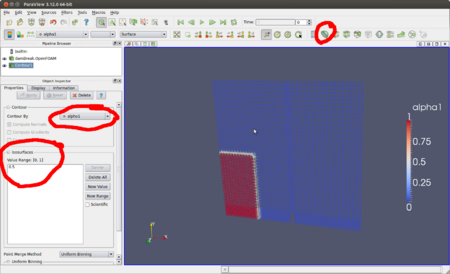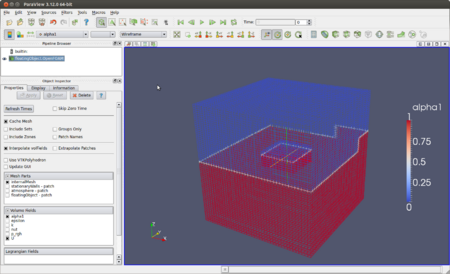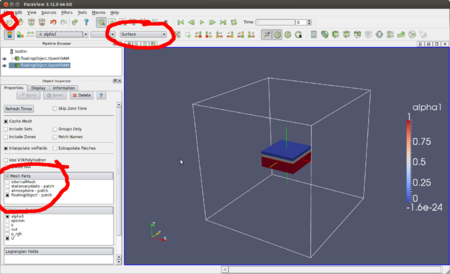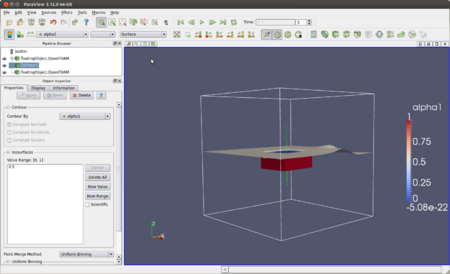Difference between revisions of "HowTo post-process multiphase results"
From OpenFOAMWiki
(Kick off this page. Will continue in a few minutes) |
(→Steps using {{tt|paraFoam}}: Added links to images. Still need to finish this after lunch.) |
||
| Line 21: | Line 21: | ||
</li> | </li> | ||
| − | <li> | + | <li>As shown in the [[#Figure_1|Figure 1]], select the fields {{tt|alpha1}} and {{tt|p_rgh}} on the lower left and then click on the {{tt|Apply}} button on the left. |
| + | [[Image:HowTo post-process multiphase results 00.png|thumb|450px|center|<div id="Figure_1">Figure 1: This example is using the {{tt|damBreak}} tutorial. Choose the fields and apply.</div>]] | ||
</li> | </li> | ||
| − | <li> | + | <li>On [[#Figure_2|Figure 2]] is shown how you can see... |
| − | + | ||
| − | < | + | [[Image:HowTo post-process multiphase results 01.png|thumb|450px|center|<div id="Figure_2">Figure 2: Pick to see the {{tt|alpha1}} field, in {{tt|wireframe}} mode and choose to see the colour legend.</div>]] |
</li> | </li> | ||
| − | <li> | + | <li>[[#Figure_3|Figure 3]] |
| − | + | ||
| − | < | + | [[Image:HowTo post-process multiphase results 02.png|thumb|450px|center|<div id="Figure_3">Figure 3: Apply the {{tt|Contour}} filter and choose to represent the {{tt|alpha1}} field with a single isosurface at the value {{tt|0.5}}.</div>]] |
</li> | </li> | ||
| − | <li> | + | <li>[[#Figure_4|Figure 4]] |
| − | + | ||
| − | < | + | [[Image:HowTo post-process multiphase results 03.png|thumb|450px|center|<div id="Figure_4">Figure 4: Skip ahead in time and change the camera perspective to see better the isosurface between the two phases.</div>]] |
</li> | </li> | ||
| − | <li> | + | <li>[[#Figure_5|Figure 5]] |
| + | |||
| + | [[Image:HowTo post-process multiphase results 04.png|thumb|450px|center|<div id="Figure_5">Figure 5: Choose to see the outline of the geometry, to make it easier to see the isosurface.</div>]] | ||
</li> | </li> | ||
| − | <li> | + | <li>[[#Figure_6|Figure 6]] |
| + | |||
| + | [[Image:HowTo post-process multiphase results 05.png|thumb|450px|center|<div id="Figure_6">Figure 6: Another example, now using the {{tt|floatingObject}} tutorial.</div>]] | ||
</li> | </li> | ||
| − | <li> | + | <li>[[#Figure_7|Figure 7]] |
| + | |||
| + | [[Image:HowTo post-process multiphase results 06.png|thumb|450px|center|<div id="Figure_7">Figure 7: Open the same case twice and choose to see the surface of only the patch for the floating block.</div>]] | ||
</li> | </li> | ||
| − | <li> | + | <li>[[#Figure_8|Figure 8]] |
| + | |||
| + | [[Image:HowTo post-process multiphase results 07.png|thumb|450px|center|<div id="Figure_8">Figure 8: Here's what it looks like when using the isosurface on the first file.</div>]] | ||
</li> | </li> | ||
| − | <li> | + | <li>[[#Figure_9|Figure 9]] |
| + | |||
| + | [[Image:HowTo post-process multiphase results 08.png|thumb|450px|center|<div id="Figure_9">Figure 9: What it looks like at {{tt|0.3}} s.</div>]] | ||
</li> | </li> | ||
</ol> | </ol> | ||
| − | |||
= Tips = | = Tips = | ||
* How to keep track of the height at a certain position: [http://www.cfd-online.com/Forums/paraview/112572-temporal-analysis.html#post405615 Temporal Analysis - post #2] | * How to keep track of the height at a certain position: [http://www.cfd-online.com/Forums/paraview/112572-temporal-analysis.html#post405615 Temporal Analysis - post #2] | ||
Revision as of 13:36, 6 October 2013
1 Introduction
OpenFOAM handles multiphase simulations with the interFoam solvers through using a single field that represents the phase present at a certain cell, face or vertex. The field is usually named alpha or alpha1.
Therefore, given that it's a single field, this means that:
- values of 0 indicates that the phase at that cell/face/vertex is only the first phase;
- while 1 indicates that it's only the second phase.
- Anything in between is a mixture of the two phases, at a reason implied by the value.
The simplest example is 0.5, which means that it's a mix of equal proportion of the first and the second phase. In other words, this should be an indication of where the separation surface is between each phase.
- Notes
- Make sure to study well the tutorial damBreak, as explained in OpenFOAM's User Guide: 2.3 Breaking of a dam
2 Steps using paraFoam
- After running the multiphase solver, run paraFoam:
paraFoam
- As shown in the Figure 1, select the fields alpha1 and p_rgh on the lower left and then click on the Apply button on the left.
- On Figure 2 is shown how you can see...
- Figure 3
- Figure 4
- Figure 5
- Figure 6
- Figure 7
- Figure 8
- Figure 9
3 Tips
- How to keep track of the height at a certain position: Temporal Analysis - post #2
